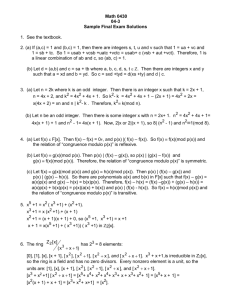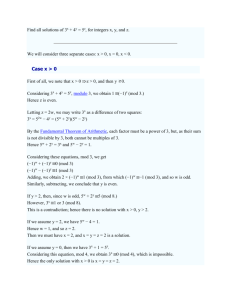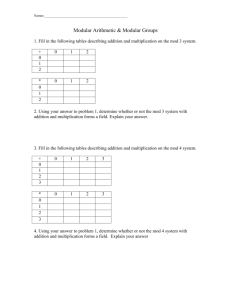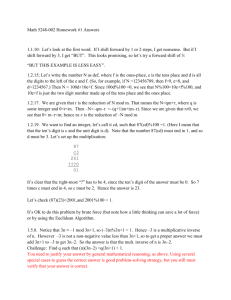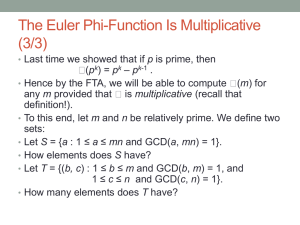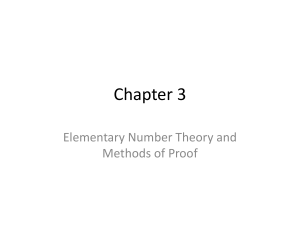doc
advertisement
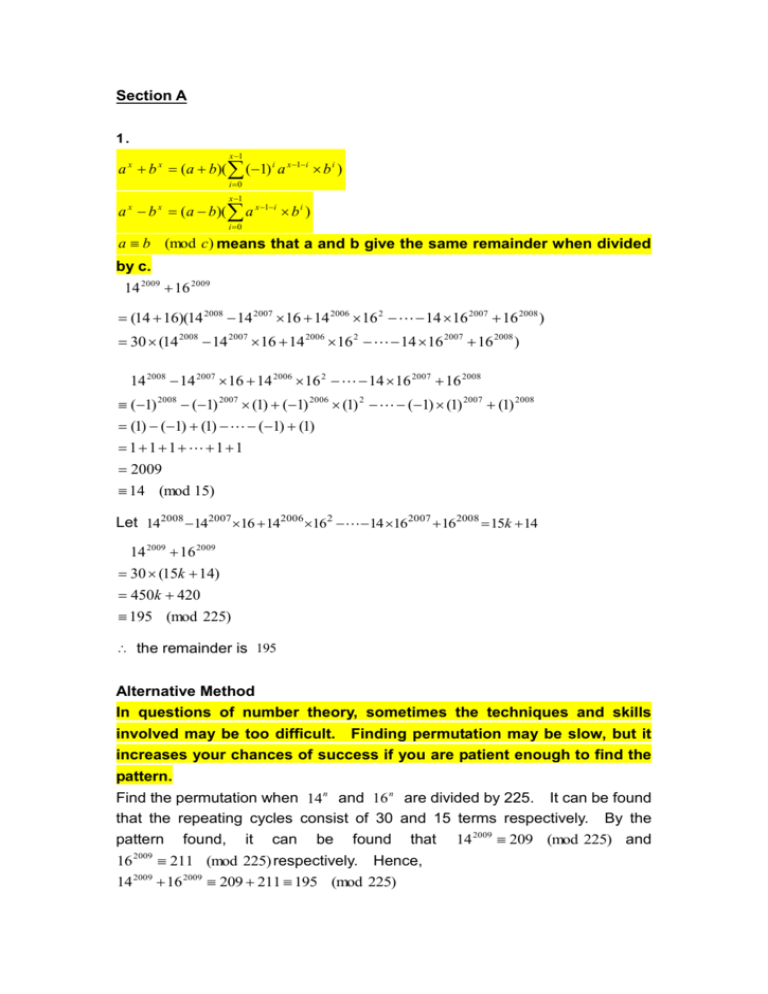
Section A 1. x 1 a x b x (a b)( (1) i a x 1i b i ) i 0 x 1 a x b x (a b)( a x 1i b i ) i 0 a b (mod c) means that a and b give the same remainder when divided by c. 14 2009 16 2009 (14 16)(14 2008 14 2007 16 14 2006 16 2 14 16 2007 16 2008 ) 30 (14 2008 14 2007 16 14 2006 16 2 14 16 2007 16 2008 ) 14 2008 14 2007 16 14 2006 16 2 14 16 2007 16 2008 (1) 2008 (1) 2007 (1) (1) 2006 (1) 2 (1) (1) 2007 (1) 2008 (1) (1) (1) (1) (1) 11111 2009 14 (mod 15) Let 142008 142007 16 142006 162 14 162007 162008 15k 14 14 2009 16 2009 30 (15k 14) 450k 420 195 (mod 225) the remainder is 195 Alternative Method In questions of number theory, sometimes the techniques and skills involved may be too difficult. Finding permutation may be slow, but it increases your chances of success if you are patient enough to find the pattern. Find the permutation when 14 n and 16 n are divided by 225. It can be found that the repeating cycles consist of 30 and 15 terms respectively. By the pattern found, it can be found that 14 2009 209 (mod 225) and 16 2009 211 (mod 225) respectively. Hence, 14 2009 16 2009 209 211 195 (mod 225) 2. It is always easier to count something in a systematical way. 11 square(s) : 9 5 45 2 2 square(s) : 4 5 20 3 3 square(s) : 9 4 4 square(s) : 0 5 5 square(s) : 0 6 6 square(s) : 4 7 7 square(s) : 0 8 8 square(s) : 0 9 9 square(s) : 1 45 20 9 4 1 79 there are 79 squares in the diagram. 3. Originally, there are 1 2 3 n sweets in total. After the students with an even number of sweets eat all their sweets, 1 3 5 k sweets are left (where k is the largest odd number not exceeding n ). 1 3 5 k 25 1 k 2 ( ) 52 2 k 9 n 9 or 10 4. Let the six-digit integer be ABCDEF Let x AB and y CDEF 9 ABCDEF CDEFAB 9 (10000 x y ) 100 y x 89999 x 91 y 989 x y x is a two-digit integer while y is a four-digit integer. Hence, x 10 If x 11 , y 11 989 10879 is not a four-digit integer. Therefore, x 10 , y 9890 , and the number is 109890 5. As B' E is the perpendicular bisector of AB , we have B' A B' B We also have AB' AB by the construction of B' Therefore AB AB' BB' , and ABB' is an equilateral triangle. BAB' 60 Consider quadrilateral ABGB ' BGB' 360 GB' A B ' AB ABG 360 90 60 90 120 B' GC 180 BGB' 60 6. For multiples of 9, the sum of its digit must be a multiple of 9. For multiples of 11, the difference between sum of odd-numbered digits and the sum of even-numbered digits must be a multiple of 11. 101 From 9 | 1010 , n digits 9 | (1 0 1 0 1 0 1) Therefore, there are 9k 1 ’s for some positive integer k 101 From 11 | 1010 , n digits 11 | (1 1 1 1) (0 0 0) Therefore, there are 11l 1 ’s for some positive integer l Together, there are 99m 1 ’s for some positive integer m There are at least 99 1 ’s the smallest n is 197 7. It is easy to see that 125 53 | 65 2009 65 2009 12009 1 (mod 8) 65 2009 0 (mod 125 ) Solving 2009 65 1 (mod 8) By observing 8 numbers, 65 2009 625 (mod 1000 ) the last three digits of 652009 is 625 8. Please remember to fill in the unit. Assume a , b , c , d , e are the time needed to fill up the pool by opening pipe A , B , C , D , E only, respectively. 1 1 1 1 a b c 4 1 1 1 1 b c d 5 1 1 1 1 c d e 6 1 1 1 1 1 1 1 1 1 1 1 1 ( )( )( ) a b c b c d c d e 4 5 6 1 1 1 13 a c e 60 60 hours is needed. 13 9. It is possible that a problem has no solution. Don’t hesitate if you find this result and are sure all your steps are correct. If x 1 , ( x 1) 2 0 x2 2x 1 0 2x 1 x2 2x 1 x (x 1 0) 2 x@ x x ( x @ x) @ x ( x @ x) x 1 x x 1 x@ x x [( x @ x) @ x] @ x x Hence, there is no solution other than x 1 10. Denote right, downwards and diagonally downwards to the right by R, D and G respectively. If the King does not move diagonally, it must move 3R and 3D in some permutation. Number of possible routes 6! 3!3! 20 If the King moves diagonally once, it must move 1G, 2R and 2D in some permutation. Number of possible routes 5! 1! 2 ! 2 ! 30 Similarly, total number of possible routes is : 6! 5! 4! 3! 3 ! 3 ! 1 ! 2 ! 2 ! 2 !1 !1 ! 3 ! 20 30 12 1 63 Section B 1. Conditional Probability = possible (outcomes) given P(Draw a red ball and lie) 1 1 3 5 2 4 1 1 3 5 3 5 1 15 8 1 15 15 1 15 9 15 1 9 Alternative Method: List out all outcomes 2. Note that x2 0 or 1 (mod 3) To have (2 p 2 3) 2 ( p 2) 2 224 2 1 (mod 3) We must have (2 p 2 3) 2 0 (mod 3) and ( p 2) 2 1 (mod 3) From (2 p 2 3) 2 0 (mod 3) 2 p 2 3 0 (mod 3) 2 p 2 0 (mod 3) p 2 0 (mod 3) p 0 (mod 3) As p is a prime, p 3 Always check your answer if the problem requires you to solve an equation. Sometimes you may forget to reject some cases. Checking : (2(3) 2 3) 2 (3 2) 2 15 2 12 224 Hence, p 3 is the only solution. 3. Only square numbers can have odd number of factors. Assume ai x 2 If x 1 , ai 1 only has 1 positive divisor. If x 1 , ai has 1 , x , x 2 as factors. Hence, x does not have any other factors except 1 and x . x is a prime. Each ai is the square of a prime, so a10 is the square of the tenth prime, i.e. a10 29 2 841 4. To be the sides of a triangle, the lengths must satisfy triangle inequality. The three lengths are x , y and 100 x y respectively. x y 100 x y y (100 x y ) x x (100 x y ) y x y 50 50 x 50 y When x 1 , y has 0 choices. When x 2 , y has 1 choice. When x 3 , y has 2 choices. When x 49 , y has 48 choices However, we should discard the case x y , where there are 24 choices. P( x , y and 100 x y can form a triangle) 1 2 48 24 100 99 (1 48) 48 24 2 9900 1152 9900 32 275 5. Cosine Law: In a Triangle ABC, AC AB 2 BC 2 2 AB BC cos ABC Join the segments FE , FC ABC FEA (ext. opp. int . ) BAD ( in alt. segment) 60 BFC 90 ( in semi circle) BF cos 60 2 BF 8 BC By Cosine Law, AC AB 2 BC 2 2 AB BC cos 60 1 7 2 8 2 2(7)(8)( ) 2 57 Section C 1. The diagram is composed of four figures. To state clearly, region I is the moon-shaped figure. Region II is the V-shaped figure. Region III is the convex-shaped figure, and region IV is an equilateral triangle. Note the followings : I 2 II 3 III IV II III IV IV 1 3 2 )r I ( 6 2 1 2 II 6 r III ( 1 3 )r 2 6 4 IV 3 r 2 4 area of circle r 2 III IV 1 area of a 60 sec tor r 2 6 r r r 2 ( )2 2 3 r2 2 4 Required ratio 3 III IV 3 I 3 II 3 III IV 1 3 3 3 2 ( )r 2 4 4 1 3 3 1 1 3 3 3 2 ( )r 2 2 2 2 4 4 3 3 2 3 3 2 5 3 6 9 2 12 1 1 2 k 2. 1 (1 k )k 2 2 k (k 1) 1 1 2( ) k k 1 k 1 1 1 2 1 2 k k 1 1 1 1 1 1 1 2( ) 2( ) 2( ) 2 3 3 4 k k 1 k 1 1 1 2( ) 2 k 1 k k 1 1 2( ) 2(k 1) k k 1 1 k 1 k 2k k 1 k 1 2 1 2 1 3 1 1 1 1 1 2 1 2 1 2 3 11 2 1 2009 1 2 2 2 1 (2 3 4 2010 ) 2 1 (2010 2)(2009 ) 2 2 1010527 1 3. 2009 1 1 1 1 2 1 2 2009 Solution 1 S1 12 4 2 7 2 298 2 Let , S 2 2 2 52 82 299 2 S3 32 6 2 9 2 300 2 32 (12 2 2 32 100 2 ) 100 101 201 9 6 S1 S 2 S3 12 22 32 300 2 300 301 601 6 S 2 S1 (22 12 ) (52 42 ) (299 2 298 2 ) (2 1) (5 4) (299 298) 3 9 15 597 (3 597 )(100 ) 2 30000 and ( S1 S 2 S3 ) ( S3 ) ( S 2 S1 ) 2 300 301 601 100 101 201 9 30000 6 6 2 50(301 601 3 101 201) 30000 2 50(180901 60903 ) 30000 2 50(119998 ) 30000 2 5999900 30000 2 5969900 2 2984950 S1 Solution 2 12 42 7 2 298 2 100 (3i 2)2 i 1 100 (9i 2 12i 4) i 1 100 9 i 2 12 i 1 100 i 1 i4 100 1 i 1 100 101 201 (1 100 ) 100 12 400 6 2 3045150 60600 400 9 2984950

